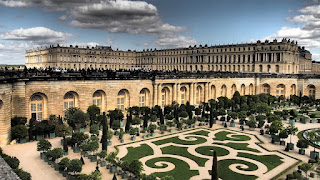 |
Photo of Versailles Castle by ahundt at
https://pixabay.com/photos/versailles-castle-paris-sightseeing-880359/ |
This world history resource focuses on Absolute Monarchs
in Europe from 1500 to 1800 and includes quiz questions
and answers and video links to related topics.
I utilized World History: Patterns of Interaction (Holt McDougal)
for our world history textbook. It has multiple options for
different learning styles and covers a wide array of information.
This quiz accompanies Chapter 21: pages 586-619.
Directions for the quiz:
- Scroll down and click on the thumbnail to enlarge to full screen.
- Click on the graphic to advance to the next screen.
- Choose an answer for each question.
- Compare your answers with those provided.
If you are interested in a group and/or interactive version of this quiz,
log in to Kahoot! and search for Week 21 World History by Katrena.
Below are free videos to accompany chapter 21:
Thanks for visiting my Student Survive 2 Thrive blog.
Navigate my blog easily through my site map, topics
tabs on the right, or via my search bar.
Here are a few of my articles you may also find helpful this week:
 |
| World History Week 21: Absolute Monarchs in Europe 1500-1800 |
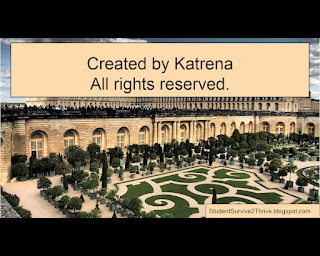 |
| Created by Katrena. All rights reserved. |
 |
| Which of the following was NOT a part of Philip II’s empire by 1600? Answer choices include: Spain, Spanish American colonies, Portuguese strongholds in Africa/India/East Indies, Holy Roman Empire |
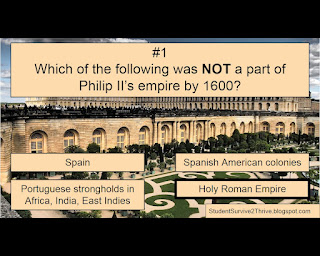 |
| The correct answer is Holy Roman Empire. |
 |
| Who was the court painter for Spain’s Philip IV? Answer choices include: El Greco, Diego Velazquez, Rembrandt van Rijn, Vincent van Gogh |
 |
| The correct answer is Diego Velázquez. |
 |
| Spain did not develop a middle class because most of its tax burden fell on the ______. Answer choices include: upper classes, lower classes, nobility, explorers |
 |
| The correct answer is lower classes. |
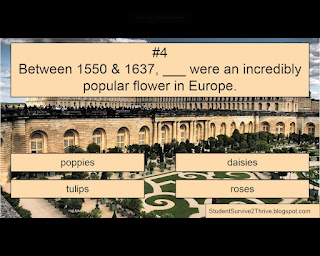 |
| Between 1550 & 1637, ___ were an incredibly popular flower in Europe. Answer choices include: poppies, daisies, tulips, roses |
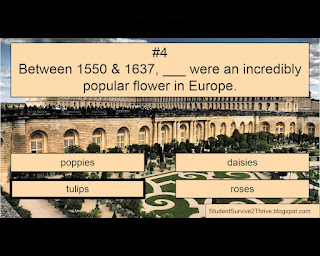 |
| The correct answer is tulips. |
 |
| In the 17th century, ___ boasted the world’s largest fleet of ships. Answer choices include: England, Spain, China, the Netherlands |
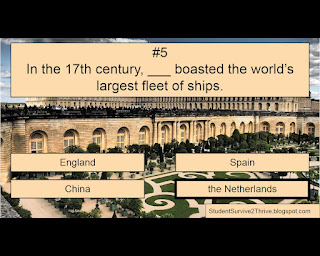 |
| The correct answer is the Netherlands. |
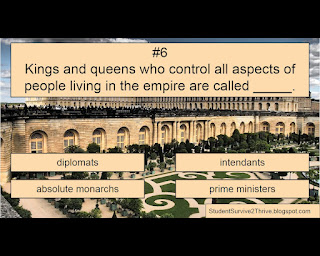 |
| Kings and queens who control all aspects of people living in the empire are called _____. Answer choices include: diplomats, intendants, absolute monarchs, prime ministers |
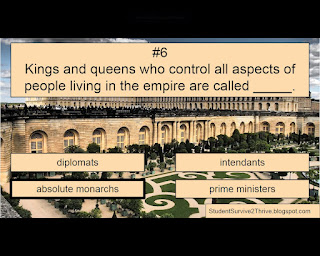 |
| The correct answer is absolute monarchs. |
 |
| In 1598, Henry IV declared Huguenots could own houses of worship through the ____. Answer choices include: Edict of Nantes, Nicene Creed, Emancipation Proclamation, Order of Retaliation |
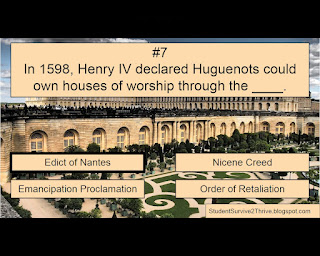 |
| The correct answer is Edict of Nantes. |
 |
| ____ involves a doubtful attitude & the belief that nothing can be known for certain. Answer choices include: Optimism, Merchantilism, Realism, Skepticism |
 |
| The correct answer is Skepticism. |
 |
| Jean Baptiste Colbert made changes to help France to become more ____. Answer choices include: interdependent, self-sufficient, dependent, beautiful |
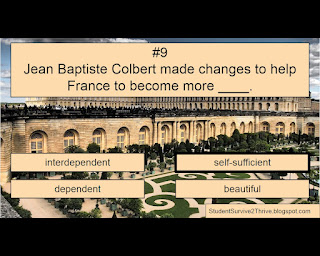 |
| The correct answer is self-sufficient. |
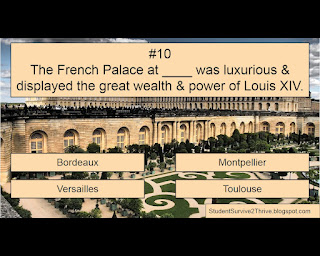 |
| The French Palace at ____ was luxurious & displayed the great wealth & power of Louis XIV. Answer choices include: Bordeaux, Montpellier, Versailles, Toulouse |
 |
| The correct answer is Versailles. |
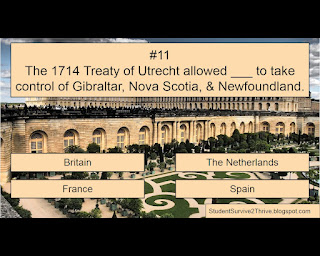 |
| The 1714 Treaty of Utrecht allowed ___ to take control of Gibraltar, Nova Scotia, & Newfoundland. Answer choices include: Britain, the Netherlands, France, Spain |
 |
| The correct answer is Britain. |
 |
| What leader shifted the tide of the 30 Years’ War? Answer choices include: Ferdinand II, Gustavus Adolphus of Sweden, Charles II, Philip of Anjou |
 |
| The correct answer is Gustavus Adolphus of Sweden. |
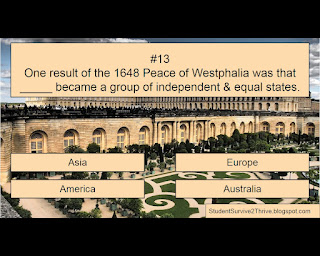 |
| One result of the 1648 Peace of Westphalia was that _____ became a group of independent & equal states. Answer choices include: Asia, Europe, America, Australia |
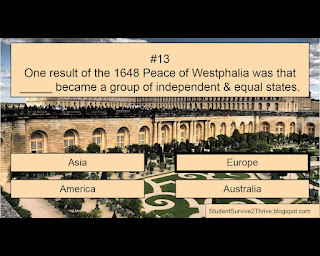 |
| The correct answer is Europe. |
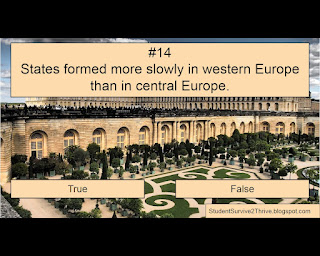 |
| States formed more slowly in western Europe than in central Europe. Answer choices include: true, false |
 |
| The correct answer is false. |
 |
| Who took the throne after Charles VI & ruled Austria, Hungary, and Bohemia? Answer choices include: Frederick the Great, Frederick William I, Maria Theresa, Louis XIV |
 |
| The correct answer is María Theresa. |
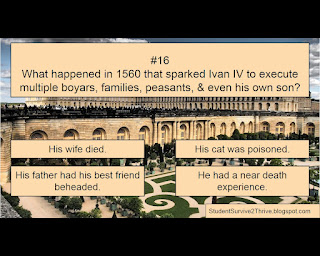 |
| What happened in 1560 that sparked Ivan IV to execute multiple boyars, families, peasants, & even his own son? Answer choices include: His wife died. His cat was poisoned. His father had his best friend beheaded. He had a near death experience. |
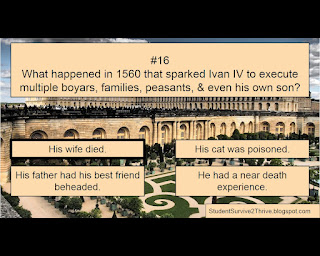 |
| The correct answer is: His wife died. |
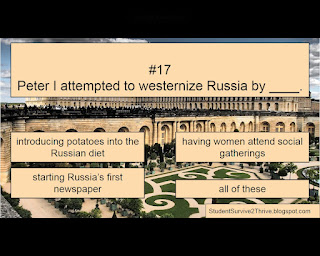 |
| Peter I attempted to westernize Russia by ____. Answer choices include: introducing potatoes into the Russian diet, having women attend social gatherings, starting Russia's first newspaper, all of these |
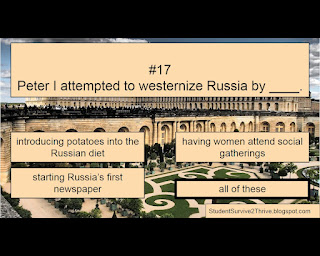 |
| The correct answer is: all of these. |
 |
| ____, although located on a swamp, became Russia’s “window on Europe,” making it easier to travel west. Answer choices include: Moscow, Siberia, Verkhoyansk, St. Petersburg |
 |
| The correct answer is St. Petersburg. |
 |
| ____’s army defeated the Cavaliers & in 1649 brought King Charles I to trial for treason & publically executed him. Answer choices include: José Félix Uriburu. Oliver Cromwell, William Laud, Anne of Denmark |
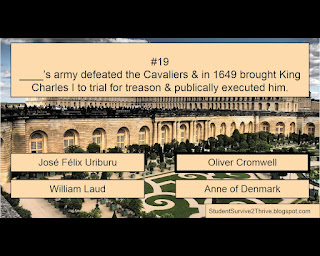 |
| The correct answer is Oliver Cromwell. |
 |
| A document preventing authorities from holding a person in jail without being charged is called a ____. Answer choices include: Quid pro quo, Pro bono, Habeas corpus, Ipso facto |
 |
| The correct answer is: Habeas corpus. |
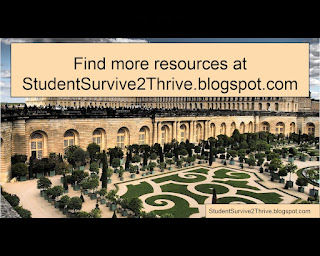 |
| Find more resources at StudentSurvive2Thrive.blogspot.com |












































No comments:
Post a Comment
Thanks for reading my article and sending your comment! Please note that I do not place links to other web sites on this blog.
Note: Only a member of this blog may post a comment.